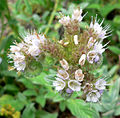| Phacelia | |
|---|---|
 | |
| Phacelia tanacetifolia | |
| Scientific classification | |
| Kingdom: | Plantae |
| Clade: | Tracheophytes |
| Clade: | Angiosperms |
| Clade: | Eudicots |
| Clade: | Asterids |
| Order: | Boraginales |
| Family: | Hydrophyllaceae |
| Genus: | Phacelia Juss. (1789) |
| Type species | |
| Phacelia secunda | |
| Diversity | |
| About 200 species | |
| Synonyms [1] | |
| |
Phacelia (phacelia, scorpionweed, heliotrope ) is a genus of about 200 species of annual or perennial herbaceous plants in the family Hydrophyllaceae, native to North and South America. California is particularly rich in species with over 90 recorded in the region. [2]
Contents
The genus includes both annual and perennial species. [2] Many have been cultivated as garden and honey plants.
The mining bee Andrena phaceliae is a specialist pollinator of this genus in the Eastern United States.












